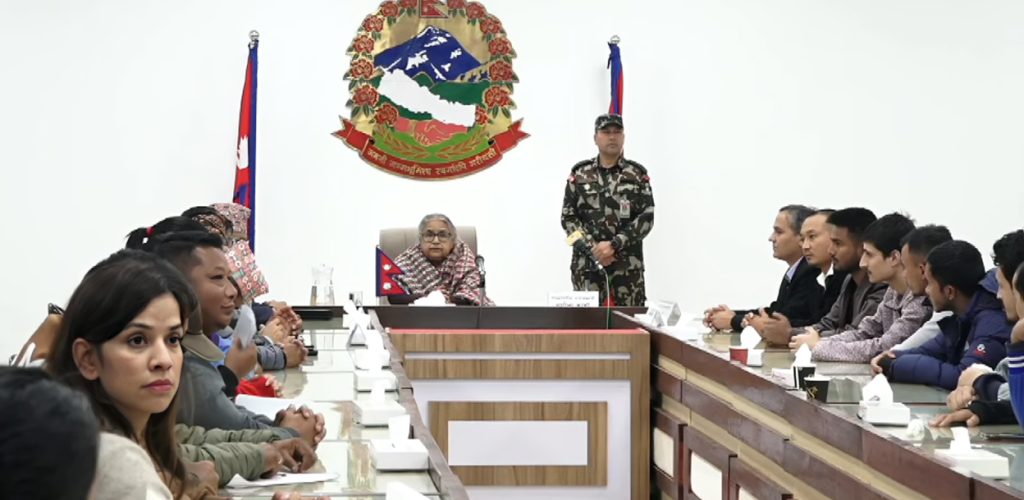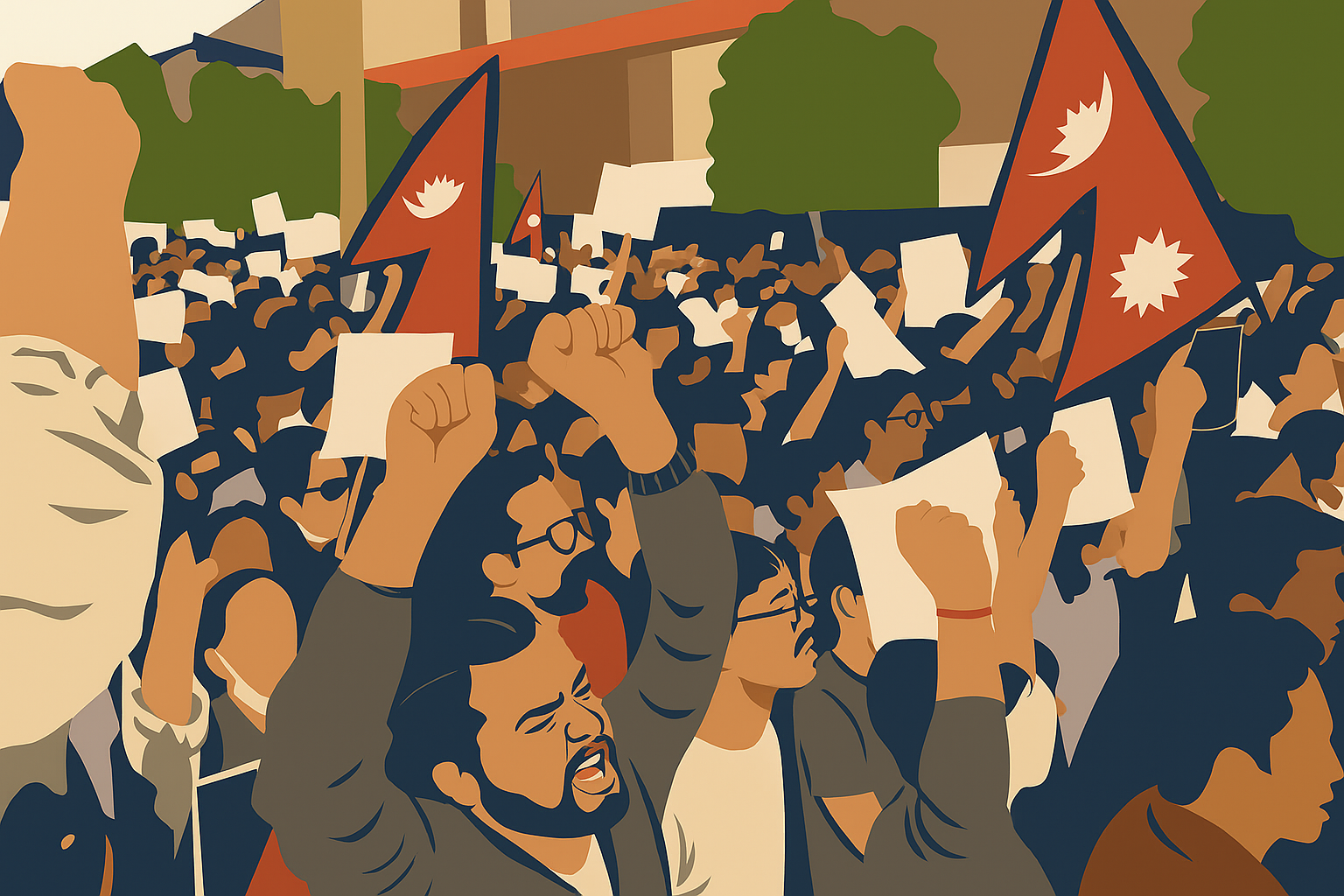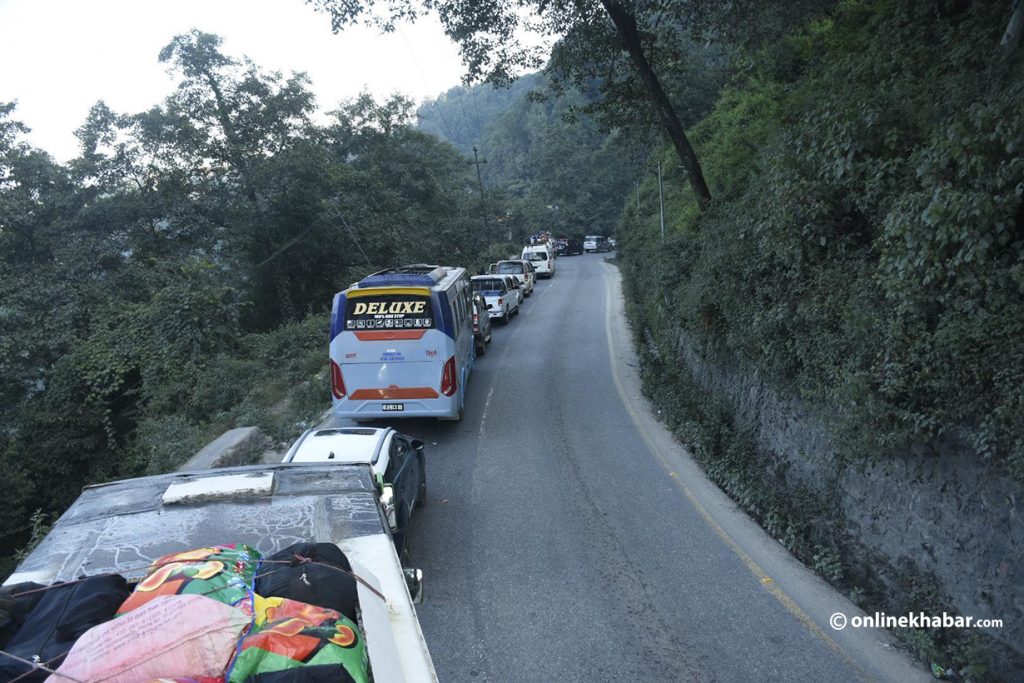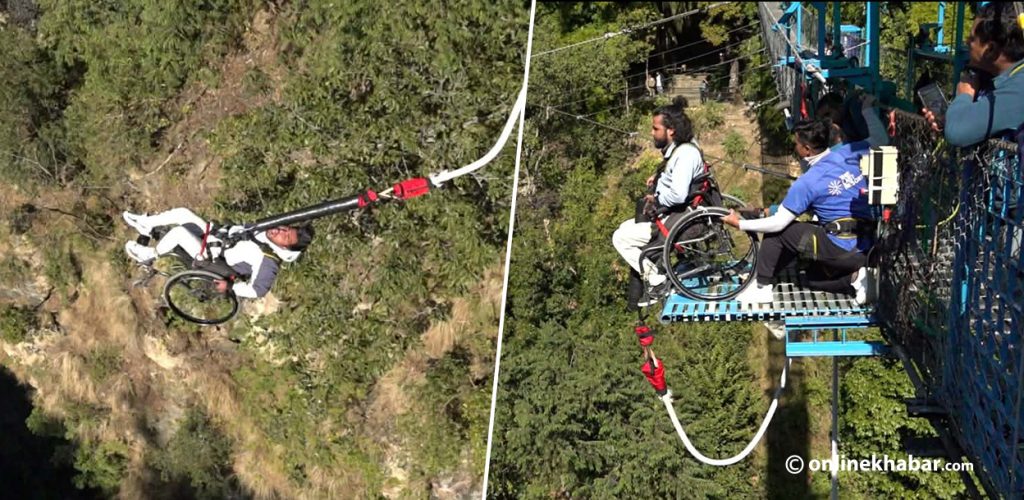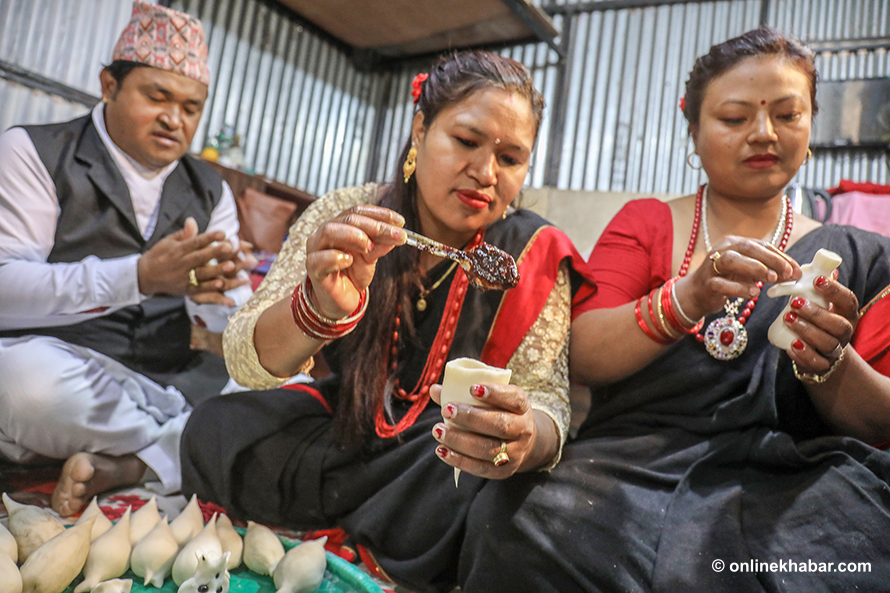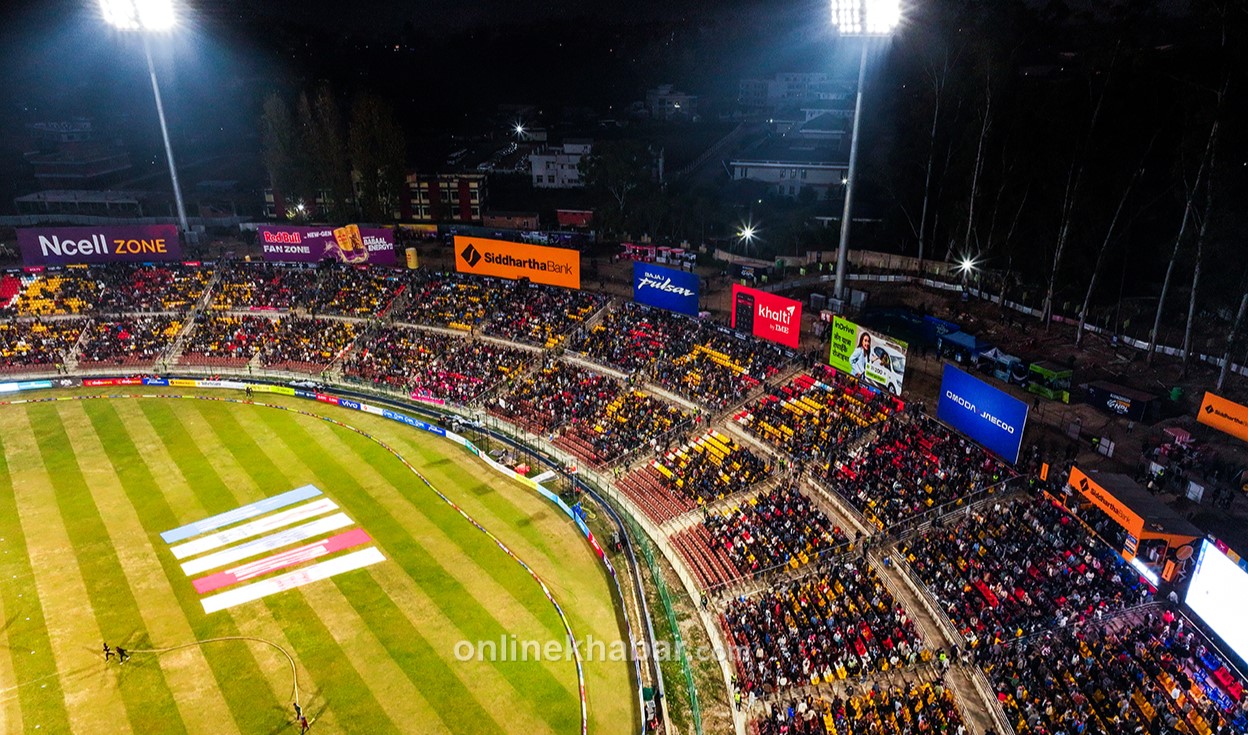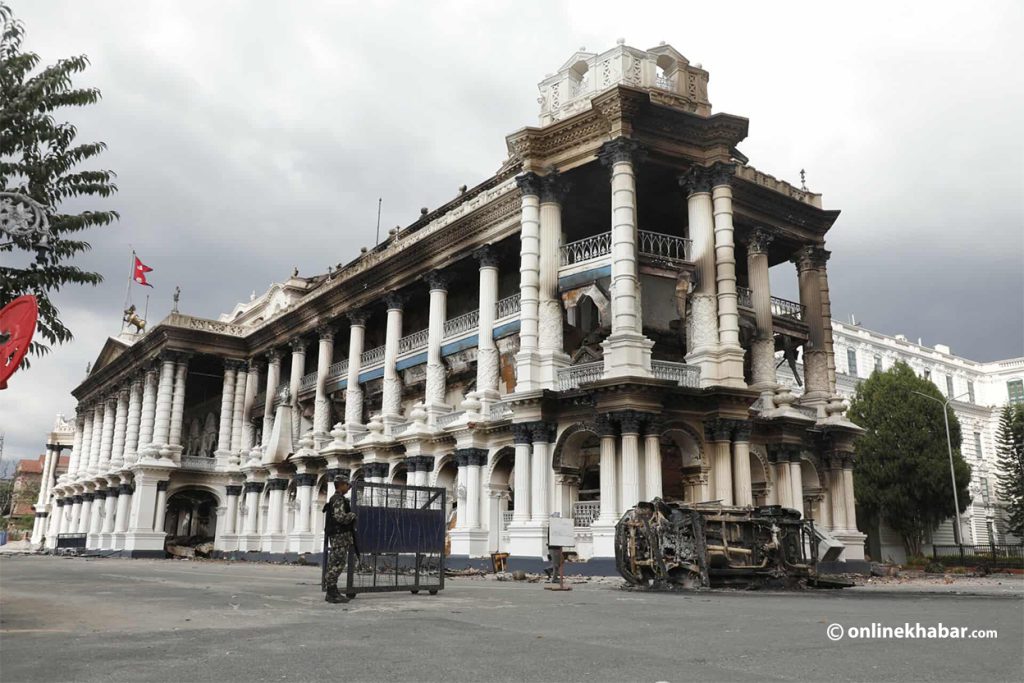
Nepal has entered a new chapter in its political history, not through the deliberations of seasoned lawmakers or the strategies of established parties, but through the defiant voices of its youth. The recent Gen Z-led uprising, triggered by a sweeping ban on social media platforms, has not only dismantled the sitting government but also exposed the deep fractures within Nepal’s democratic framework. This is not merely a protest it is a generational reckoning.
On the surface, the government’s decision to ban 26 social media platforms was framed as a national security measure. Officials cited concerns over misinformation, foreign influence, and moral degradation. But the timing and scope of the ban suggested something more sinister: a calculated attempt to silence dissent and control the narrative.
For Nepal’s youth, who rely on digital platforms for communication, activism, and creative expression, the ban was not just inconvenient it was existential. It struck at the heart of their identity and autonomy. Within hours, protests erupted across urban centers, coordinated through encrypted apps and offline networks. The message was clear: the state may control the streets, but it cannot control the cloud.
A movement without masters
What made this uprising unique was its structure or lack thereof. There were no party flags, no central leadership, no formal demands. Instead, there was a shared sense of betrayal and a collective refusal to be governed by a system that no longer represented them.
This leaderless model was both a strength and a vulnerability. It allowed for rapid mobilisation and adaptability, but it also made the movement difficult to negotiate with. The absence of figureheads meant that the state could not co-opt or discredit the movement through targeted arrests or propaganda. Yet it also meant that the protests risked fragmentation and lacked a clear roadmap for reform.
The resignation of the sitting prime minister under pressure from the protests marked a dramatic turning point. It was not just the fall of a leader it was the collapse of a political order that had long relied on patronage, opacity, and inertia. The dissolution of parliament and the announcement of fresh elections were seen by many as overdue, but they also raised uncomfortable questions.
Was this a genuine reset or a tactical retreat? Could a caretaker government, however well-intentioned, navigate the complexities of a nation in flux? And most importantly, would the youth accept a return to business as usual?
Protest or paradigm shift

At the heart of this moment lies a critical debate: is this a fleeting rebellion or the beginning of a sustained revolution? Revolutions require more than outrage, they demand vision, structure, and endurance. The Gen Z uprising has demonstrated remarkable courage and creativity, but it remains to be seen whether it can translate its energy into institutional change.
Critics argue that the movement is impulsive, idealistic, and lacking in policy depth. Supporters counter that the old system has failed so thoroughly that even imperfect disruption is preferable to continued stagnation. The truth likely lies somewhere in between. The movement has succeeded in breaking the spell of political complacency. Now it must build something better in its place.
Nepal’s traditional political parties now face an existential crisis. For decades, they have relied on identity politics, rural patronage, and revolutionary nostalgia to maintain their grip on power. But these tools are losing their potency in a digital, urbanising, and globally connected Nepal.
The generational divide is stark. While the old guard speaks in the language of ideology and legacy, the youth speaks in the language of rights, transparency, and innovation. This is not just a political shift it is a cultural one. And it demands a rethinking of how power is earned, exercised, and held accountable.
Technology played a dual role in this uprising: it was both the battleground and the weapon. The government’s attempt to suppress dissent by banning social media backfired spectacularly. Instead of silencing voices, it amplified them. VPN usage surged, encrypted apps became lifelines, and offline mesh networks sprang up in rural areas.
But technology is a double-edged sword. The same tools that empower dissent can also enable surveillance, misinformation, and polarization. As Nepal moves towards elections, the challenge will be to harness digital tools for democratic deepening not digital demagoguery.
Amid the euphoria of political change lies a trail of pain. Clashes between protesters and security forces resulted in civilian casualties, including teenagers whose deaths became symbols of resistance. Their faces now adorn murals, their names echo in chants, and their stories fuel the movement’s resolve.
The state’s response to these deaths will be a litmus test for its sincerity. Will there be independent investigations? Will accountability follow? Or will these lives be reduced to statistics in a transitional narrative?
Global reaction: Applause and apprehension
The international community has responded with cautious optimism. Human rights organisations praised the youth’s courage, while regional powers watched with concern. Nepal’s strategic location makes it a focal point for geopolitical interests, and foreign actors are wary of instability.
Support for democratic aspirations must be principled, not opportunistic. Nepal’s future must be shaped by Nepalis not by foreign agendas or diplomatic calculations.
As the country prepares for elections, the stakes could not be higher. Will the energy of the streets translate into electoral power? Can new political formations emerge that reflect the aspirations of the youth? Or will the old guard regroup, rebrand, and reclaim power?
The Gen Z movement has opened a door. Walking through it will require more than protest. It will require policy, patience, and political maturity. It will require turning slogans into statutes and rage into reform.
Nepal stands at a crossroads. One path leads back to the familiar a cycle of disillusionment, co-optation, and decay. The other leads forward towards a more transparent, inclusive, and accountable democracy.
The choice is not just for politicians to make. It is for every citizen, every voter, every voice that rose in protest. The digital rebellion has done its job: it has shaken the system. Now comes the harder part building something better in its place.
The most pressing question now is whether this movement can evolve from street-level resistance into institutional transformation. Protests, no matter how powerful, are transient by nature. They disrupt, they awaken, they demand but they do not govern. For Nepal’s youth to truly reshape the nation, they must engage with the slow, often frustrating machinery of policy, lawmaking, and governance.
This means forming political platforms that reflect their values. It means drafting manifestos, contesting elections, and building coalitions. It means learning to negotiate, compromise, and legislate without losing the moral clarity that fueled the uprising. It also means resisting the temptation to replicate the very systems they fought against: personality cults, opaque funding, and ideological rigidity.
Reimagining democracy in the digital age
Nepal’s democracy, like many others, was built in an analog era. Its institutions, processes, and norms were designed for a slower, more hierarchical society. But the digital age demands agility, transparency, and participatory governance. The Gen Z uprising is not just a political event it is a wake-up call to reimagine democracy itself.
This could mean introducing digital referendums, open-source policy platforms, and blockchain-based voting systems. It could mean redefining citizenship to include digital rights, data ownership, and algorithmic accountability. It could mean creating civic tech hubs where citizens co-create solutions with policymakers.
Such innovations will not be easy. They will face resistance from entrenched interests and bureaucratic inertia. But they are necessary if Nepal is to build a democracy that is not just functional, but future-proof.
One of the most overlooked aspects of the uprising is the battle for narrative. For decades, Nepal’s political discourse has been shaped by legacy media, party propaganda, and elite intellectuals. But the Gen Z movement has disrupted this monopoly. Through memes, podcasts, livestreams, and citizen journalism, young Nepalis have reclaimed the power to tell their own stories.
This democratisation of narrative is both liberating and dangerous. It allows for pluralism and creativity, but it also opens the door to misinformation, echo chambers, and digital populism. As Nepal rebuilds, it must invest in media literacy, critical thinking, and ethical journalism. It must ensure that the digital public square remains a space for dialogue not division.
Education will play a crucial role. Schools and universities must become incubators of civic consciousness, not just exam factories. Curricula must include digital ethics, constitutional literacy, and participatory governance. Teachers must be trained to nurture dissent, not suppress it. Only then can the next generation sustain the momentum of this uprising.
The role of civil society and the diaspora
Civil society organisations, long sidelined by political elites, now have a chance to reclaim relevance. They can serve as bridges between the state and the street, offering expertise, mediation, and institutional memory. They can help translate protest energy into policy reform, monitor transitional justice, and hold interim governments accountable.
Nepal’s diaspora, too, has a role to play. With millions of Nepalis living abroad many of them digitally fluent and politically engaged the global Nepali community can offer solidarity, resources, and innovation. But this support must be grounded in humility and respect for local agency. The diaspora must amplify, not overshadow, the voices on the ground.
Despite the optimism, the road ahead is fraught with risks. The interim government may falter under pressure. Elections may be delayed or manipulated. Old political actors may rebrand themselves and co-opt the youth vote. Foreign powers may exploit the vacuum for strategic gain. And the movement itself may fracture under the weight of expectation.
There is also the risk of burnout. Many young activists have already faced trauma, arrest, and surveillance. Without institutional support and mental health resources, the emotional toll could be devastating. Sustaining a movement requires not just strategy, but care.
Nepal must also guard against the rise of digital authoritarianism. The same tools that enabled the uprising encryption, anonymity, decentralisation can be weaponised by bad actors. The state may respond with more sophisticated surveillance, censorship, and cyber warfare. A new social contract must be forged one that protects both freedom and security.
Ultimately, this is not just a political crisis it is a moral reckoning. Nepal must confront the question: What kind of society does it want to be? One that silences dissent or one that listens? One that clings to legacy or one that embraces change? One that governs through fear or one that leads through trust?
The Gen Z uprising has forced the nation to look in the mirror. It has exposed the gap between constitutional promises and lived realities. It has reminded the country that democracy is not a gift it is a practice. And that practice must be renewed, reimagined, and reclaimed by every generation.
Nepal stands at a historic crossroads. The old order has been shaken, but the new one is yet to be built. The youth have spoken loudly, creatively, and courageously. Now they must lead wisely, inclusively, and persistently.
This is not the end of a protest. It is the beginning of a possibility. A possibility that Nepal can become a model of digital democracy, generational leadership, and civic renewal. A possibility that the voices once dismissed as naïve can become the architects of a new republic.
The future is not waiting. It is already here. And it is demanding to be heard.




